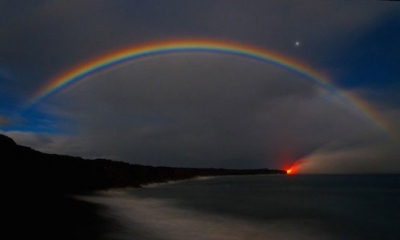
A moonbow is a rainbow produced by moonlight. Very unusual, moonbows are created when moonlight is refracted by water particles in the atmosphere. They may be spotted when there is rain nearer to the full moon phase. They are fainter than solar rainbows, because of the smaller amount of light reflected from the surface of the moon.
Like rainbows, a Moonbow forms when light—moonlight rather than sunlight—shines on water droplets. As the light passes through the droplet, it bends or “refracts,” bounces or “reflects” off the back of the droplet, and finally, exits the droplet after bending a second time. It is this bending of light which causes it to split into its individual color wavelengths of red, orange, yellow, green, blue, indigo, and violet.
However, don’t expect these colors to appear as vividly in Moonbows as they do in daytime rainbows. Since the Sun is 400,000 times brighter than a full Moon, a Moonbow’s colors tend to be fairly dim. So dim, in fact, that the light is often too weak to be picked up by the color-detecting cells in our eyes, which means we see more of a white rainbow (white being the combination of all of light’s visible colors).
Picture Credit : Google




